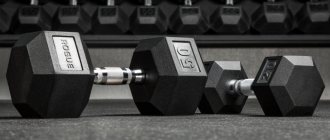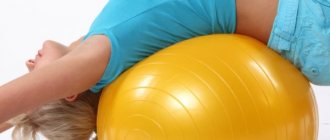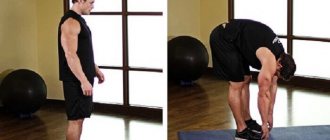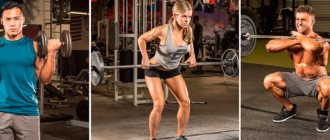Aerobic training is the performance of physical exercises, the main goal of which is to strengthen the cardiovascular system, develop endurance and burn fat.
During aerobic training, in addition to energy, muscles also require a fairly large amount of oxygen, which forces the lungs, heart and blood vessels to work much more intensely.
Aerobic workouts include running, brisk walking, swimming, cycling, jumping rope, dancing and so on. They also include all kinds of team sports, such as football, basketball, volleyball, tennis and others.
In this article we will talk about what aerobic training gives us, how to do it correctly and how to get the best results from doing it, and we will also touch on the topic of comparing aerobic and strength training.
What does aerobic training give us?
Regular aerobic training has many advantages, both physically and emotionally.
- Strengthening the heart muscle. Increasing the efficiency of its work, as well as reducing the heart rate at rest.
- Improves blood circulation and lowers blood pressure.
- Strengthening respiratory and skeletal muscles.
- Active development of body endurance.
- Losing excess weight.
- After 2-3 weeks of training, there is an improvement in mood and relief from depression.
- The quality of sleep improves, it becomes healthier and deeper, which contributes to the high-quality recovery of the body after training. A person begins to fall asleep much faster.
- The problem of lethargy, which worries many people, disappears. Regular exercise keeps you alert throughout the day.
Also, an undeniable advantage of aerobic training is that, due to the increased speed of blood circulation, it increases a person’s life expectancy and makes it possible to look younger than one’s age. Aerobic training is an excellent prevention of most diseases, especially cardiovascular diseases.
Aerobic exercises at home
If you don't have the opportunity to regularly run at the stadium or go to the gym, you can exercise at home on your own. These can be weight loss exercises performed to rhythmic music:
Training on exercise machines is no less useful. When choosing an exercise machine for home exercise, you should first of all pay attention to an exercise bike, treadmill or elliptical trainer. A treadmill allows you to walk and run without leaving your home. But it should be understood that a treadmill will require a fairly large area. Typically, a separate room or part of a large room is set aside in the house to install a treadmill.
If you do not have excess available space, then you should take a closer look at an elliptical or exercise bike. An elliptical trainer takes up less space and allows you to create a load not only on the leg muscles, but also on the arm muscles and shoulder muscles, allowing you to burn calories more efficiently. If you don’t have any extra space in your apartment, you can buy a stepper. It takes up virtually no free space, is able to create a good load on the leg muscles and can be easily stored under the bed. You can watch an overview of different models of home exercise equipment in the video below:
How should you do aerobic exercise?
You probably knew about the benefits you read above even without this article. But not everyone knows how to perform such workouts so that they bring maximum results, and therefore, for most people, doing, say, jogging in the morning does not bring the desired results.
In the world of sports, each exercise has its own goal and in order to achieve it, you need to know how to do it correctly. Aerobic exercise is no exception.
Most people who start aerobics have the goal of losing weight or developing endurance. These, in principle, are the main goals of such training, the rest comes as a pleasant addition. So, to lose weight, it will not be enough to do a morning or evening jog lasting 10-15 minutes. Let's explain why.
To perform certain loads, the body needs energy, this is logical. And it would be good if it draws energy from fat deposits on our body. But, unfortunately, it consumes this energy mainly from carbohydrate reserves. This is how nature works and nothing can be done about it. However, when the supply of carbohydrates runs out, the body has no choice but to spend its own energy reserves - fats. This is exactly what we need.
When performing aerobic exercise, carbohydrate reserves are depleted within approximately 20-30 minutes. Thus, fat loss begins only after this time. Of course, we burn some fat reserves during these 20-30 minutes, but these losses are very insignificant. The optimal duration of aerobic training will be 40-45 minutes, no more, otherwise you will begin to lose muscle along with fat.
Aerobic training should be performed 3-5 times a week - this will give excellent results. If you are a beginner, you should start with 3 times a week for 15-20 minutes. This will prepare your body for further stress. Gradually, the duration of training should be increased, but not earlier than after 2 weeks.
Both beginners and experienced athletes should definitely warm up before training. It will warm up the muscles and prepare the body for exercise. Warming up also reduces the likelihood of all kinds of injuries. After finishing your workout, do not rush to sit down or stop; before doing this, you should walk around for a couple of minutes and restore your breathing.
As mentioned above, aerobic training involves a variety of exercises and activities, each of which burns a different amount of calories. Below is a table with the approximate number of calories burned per 1 minute of exercise.
Aerobic training exercises
Aerobic exercises include any type of physical activity without weights - walking, running, jumping rope, cycling, swimming, outdoor games (football, volleyball, tennis, badminton, etc.), performing movements to rhythmic music and even dancing.
Read also: How to choose the right bike?
Aerobic exercise includes step aerobics and the recently gaining popularity of exercise in the form of walking on stairs. When climbing 100 steps, an average of about 40 kcal is burned for women and 45 kcal for men. At the fitness center, you can take advantage of the opportunity to strengthen your body by exercising on an exercise bike, treadmill, stepper or special cardio machines. Aerobic exercises for burning fat differ in their effect on different muscle groups and joints. So, for example, if you are very overweight, then you should be careful when choosing a type of exercise such as running. When running, significant impact loads are placed on the knee joints. It also has a strong impact on the ankle joints.
To avoid injury and prevent the destruction of cartilage as a result of impact loads, if you are overweight, it is recommended to choose exercises on an exercise bike, elliptical trainer or stepper. A very good choice to start training if you are overweight is swimming. When swimming, all muscle groups are active, and there is no skeletal load, which occurs during exercise on land and leads to joint injuries. In general, for beginners, any cyclic exercises with a light load on the joints will be a good choice - swimming, walking, training on an elliptical trainer. The most popular types of aerobic exercise are described in this video:
Combining aerobic and strength training
In the world of bodybuilding, there is an opinion that combining aerobic and strength training is a big mistake. However, back in the late 70s, it was found that the proper combination of these workouts gives excellent results, especially in order to give muscles relief and lose excess weight.
As mentioned above, muscles need energy to overcome certain loads. The loads in strength training are very large, which means they consume a lot of energy, that is, carbohydrates.
Thus, if you conduct an aerobic workout after a heavy workout, then the reserves of carbohydrates will already be depleted and the body will spend energy from its reserves, that is, from fats, to perform aerobic exercise. This will significantly improve and speed up the result.
A huge mistake would be to do aerobic training before strength training. When we make this mistake, we start lifting weights without having the energy to do so. This will only entail strength training with very light weights, which will not be enough to increase muscle mass or strength.
The myth that aerobic exercise destroys muscle mass is not entirely a myth, but it is also not entirely true. Yes, if you really do marathon races, this will entail loss of both fat and muscle, but if you do aerobic training no more than 3 times a week lasting 15-20 minutes after strength training or 40-45 minutes of independent training, then this will only be beneficial and won't steal an ounce of your muscle.
When incorporating aerobic training into your program, it is highly recommended to increase your protein intake to 2 grams per kilogram of body weight. In other words, if you weigh 70 kg, then your daily protein intake will be 140 grams.
This can easily be achieved by drinking protein shakes or increasing your intake of protein-containing foods such as meat, fish, poultry, eggs and dairy products. But remember the fat content is also present in them and it is much higher than in protein powders.
What are aerobic exercises?
Aerobic exercise is divided into 3 main types. Type 1 is purely aerobic simple exercise with constant load (running, walking, cycling). Type 2 – more complex exercises that require special skills and are characterized by heterogeneity of load (swimming, tennis, aerobics). Type 3 is a complex, variable load exercise that requires both skill and significant strength and agility (mountain biking, rock climbing, basketball).
You should choose the type of aerobic training for yourself not only on the basis of personal liking (what you like), but also taking into account your level of preparedness (at the initial level it is better to limit yourself to type 1 exercises or, in extreme cases, type 2), as well as your state of health. For example, if you have problems with your knees or spine, then it is better to choose aerobic exercises with low skeletal load (race walking, swimming).
If you are seriously involved in aerobic training, do not forget about warming up and stretching!
How to increase the effectiveness of aerobic training?
Below are a few simple tips that will help make your aerobic workouts even more effective.
- Avoid eating foods high in carbohydrates before training. This food can be eaten three hours before training, not earlier.
- Do aerobic exercise outdoors. After all, let’s say running in the fresh air will give better results than running on a treadmill in a stuffy gym.
- The level of stress on the body must be average, otherwise aerobic training will turn into anaerobic.
- Eat enough protein.
- Combine aerobic exercise with strength training (first strength training, then aerobic exercise)
- Train regularly, namely 3-5 times a week.
What is aerobic exercise?
Aerobic exercise is physical exercise in which muscles work using energy generated through the process of aerobic glycolysis (the breakdown of glucose using oxygen). A characteristic feature of aerobic exercise is the involvement of a large number of muscle groups and a serious load on the cardiovascular system, as a result of which these exercises are also called cardio training. The ability to easily dose the load on the heart, the relatively low load on the joints, and the cyclical nature of movements make aerobic exercise an excellent means of strengthening the cardiovascular system, increasing the overall tone and endurance of the body.
After aerobic exercise
After finishing your workout, you should not immediately run to the refrigerator to refresh yourself. Within 40-50 minutes after training, the process of burning calories still continues, which allows, even after completing the exercises, to burn calories stored in subcutaneous deposits for some time. At this time, it is advisable to drink 0.5 liters of pure drinking water without gas or herbal tea to replenish the fluid lost during training. This will help prevent dehydration. To restore muscles after exercise, it is recommended to eat some whole grain bread with cheese, yogurt with fruit, or an omelet with vegetables.
*** As you can see, aerobic training can be very effective for weight loss and endurance training. In the following publications, we’ll talk in more detail about choosing various types of exercise equipment for training at home, and also learn how to exercise with them correctly.
See also:
- < Useful exercises for the back and spine
- Effective abdominal exercises >










